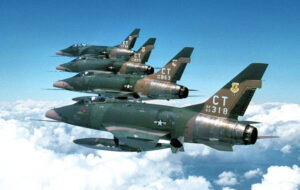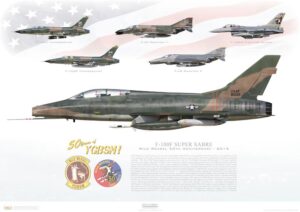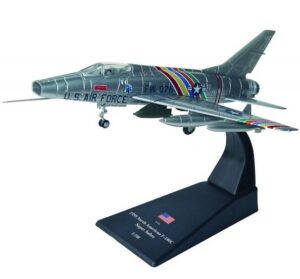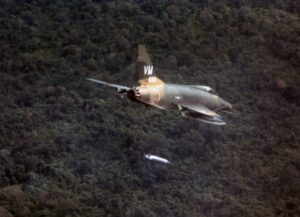Story by Dario Leone, aviationgeeks.com Jan 20, 2020. This story contains links to available purchase. Proceeds DO NOT go to the Super Sabre Society.
“The first F-100 combat mission was a disaster — what we used to call a ‘group grope’,” Capt Lloyd Houchin, former F-100 pilot.
 While the F-105 Thunderchief and F-4 Phantom II flew the majority of the fighter-bomber missions over North Vietnam, the Thunderchief’s service predecessor, the F-100 Super Sabre, stayed on to fight the air war in South Vietnam until June 1971.
While the F-105 Thunderchief and F-4 Phantom II flew the majority of the fighter-bomber missions over North Vietnam, the Thunderchief’s service predecessor, the F-100 Super Sabre, stayed on to fight the air war in South Vietnam until June 1971.
Although it was designed as an air defence fighter, and was later given nuclear capability as the mainstay of Tactical Air Command’s deterrent posture, it was the F-100’s toughness, adaptability and reliability that made it ideally suited to the incessant ‘taxi-rank’ close support and counter-insurgency missions in Vietnam. As told by Peter E Davies in the book F-100 Super Sabre Units of the Vietnam War, the jet’s four 20 mm cannon and external load of bombs, rockets and napalm defeated many enemy incursions, with US troops in contact expressing a preference for the accuracy and skill of F-100 pilots to save them in situations where ordnance had to be dropped very close to their own lines.
Nevertheless, the first F-100 combat mission was a disaster.

Former F-100 pilot Ron Bigoness recalls;
‘Our 615th TFS rotational deployment to the Philippines in 1964 started out normally but quickly became chaotic when a US Navy pilot was shot down in Laos. We quickly ended up with our aeroplanes and people in three places – the Philippines, Tainan and Da Nang. We had to cover our “nuke” targets from the Philippines and Tainan and still fly a few sorties from Da Nang.’
Yankee Team reconnaissance flights by RF-8A Crusaders of VFP-63 had commenced the previous month in support of Royal Laotian Air Force operations, and Lt Charles Klusmann’s RF-8A had been damaged by AAA on May 21. He was hit again on Jun. 6 and hydraulic failure forced him to eject. Klusmann’s Crusader was the first US Navy loss in Southeast Asia, as well as the first combat jet casualty of the war. In response to this loss, eight 615th TFS F-100Ds, led by the Clark AB wing commander Col George ‘Raven’ Laven, were sent to Da Nang AB on Jun. 7 to fly the Super Sabre’s first combat mission, out of more than 250,000 sorties flown by the end of the Vietnam War, two days later. The jets had to deploy with their own 2.75-in rocket pods as none were available at Da Nang, but they were damaged by heavy rain en route.

After receiving many contradictory instructions regarding ordnance for the mission, armourers from the 615th TFS finally loaded either rocket pods or four 500-lb bombs to the wing pylons of each F-100D for the mission, and four KC-135A tankers were deployed from Guam to support them. The target was one of the AAA sites that had downed both Klusmann’s RF-8A and a VF-111 F-8D the very next day. The target area was in poorly mapped terrain on the Plain of Jars, beyond US radar coverage and navigation aids. One of the KC-135A navigators helped the two F-100D flights locate the target coordinates, but the fighter crews had no photographic target identification, having to rely instead on a description of a small fortress structure that housed the AAA battery.
The second F-100D flight became separated from Col Laven’s leading flight and mistakenly bombed another AAA site 25 miles from the assigned target. Col Laven’s flight caused some damage to the original target but a shortage of fuel forced them to divert to Udorn RTAFB, thus ignoring specific instructions to avoid flying over Thailand. Col Laven’s jet burst a tyre on landing (which he attributed to a faulty anti-skid system) and did so again on their eventual, nocturnal, return to Da Nang, when it also cut through the cabling for the airfield’s temporary landing lights, requiring his wingman, Capt Jerry Dixon, to land in total darkness. Col Laven, who described the mission as ‘one of the worst I have ever flown’, was relieved of his command shortly afterwards, having been christened ‘the guy who bombed the wrong target’.
According to Capt Lloyd Houchin, who was in Laven’s flight, ‘The first F-100 combat mission was a disaster — what we used to call a “group grope”’. Although a few of the pilots involved had combat experience, none had previous exposure to the severe problems of operating over the unfamiliar territory of Vietnam and Laos.

Proceeds from these sales DO NOT go to the Super Sabre Society.
Photo credit: U.S. Air Force
